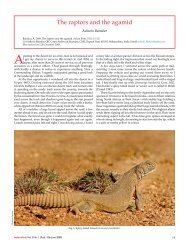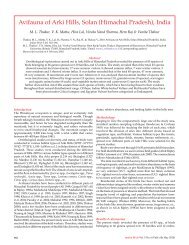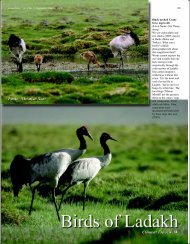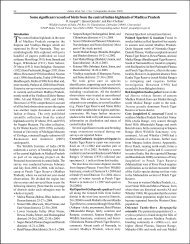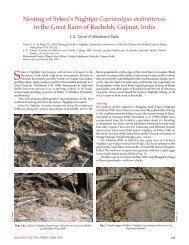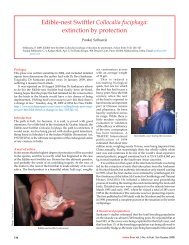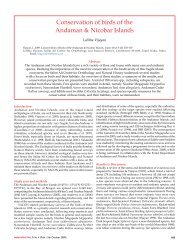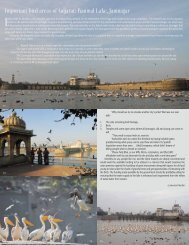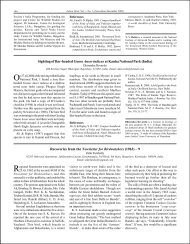The Black Baza Aviceda leuphotes in Chennai: a ... - Indian Birds
The Black Baza Aviceda leuphotes in Chennai: a ... - Indian Birds
The Black Baza Aviceda leuphotes in Chennai: a ... - Indian Birds
- No tags were found...
You also want an ePaper? Increase the reach of your titles
YUMPU automatically turns print PDFs into web optimized ePapers that Google loves.
Venkatraman: Breed<strong>in</strong>g of Glossy Ibis<strong>in</strong> both size and distribution. Probably, this could be the reasonfor the change <strong>in</strong> the population structure of many of the birds<strong>in</strong> recent years <strong>in</strong> Vedanthangal. Leslie (2001) and K<strong>in</strong>gsford &Norman (2002) suggest that successful breed<strong>in</strong>g often requiresexceptional flood<strong>in</strong>g events that last long enough for completionof the breed<strong>in</strong>g cycle. Hence, lack of competition and the <strong>in</strong>stanceof exceptional flood<strong>in</strong>g could be the likely factors for the GlossyIbis breed<strong>in</strong>g first time <strong>in</strong> Vedanthangal.AcknowlegementsI thank Dr Ramakrishna, Director, Zoological Survey of India, Kolkata, andDr K. Rema Devi, Jo<strong>in</strong>t Director and Officer-<strong>in</strong>-Charge, Mar<strong>in</strong>e BiologicalStation, Zoological Survey of India, <strong>Chennai</strong> for their encouragement. Iexpress my deep sense of gratitude to Tamil Nadu Forest Department fortheir permission.ReferencesDesai, R. N. 1996. Rare visits of some ducks, Pa<strong>in</strong>ted Stork and Glossy Ibisto the tanks of Dharwad (Karnataka: India). Newsletter for Birdwatchers36 (4): 78–79.F<strong>in</strong>layson, C. M., Gitay, H., Belio, M. G., van Dam, R. A. & Taylor, I. 2006.Climate variability and change and other pressures on wetlandsand waterbirds: impacts and adaptation. Pp. 88–97. In: Waterbirdsaround the world. (Eds.) Boere, G. C., Galbraith, C. A. & Stroud, D. A.Ed<strong>in</strong>burgh, U.K.: <strong>The</strong> Stationery Office.Kannan, R 1984. <strong>The</strong> Glossy Ibis <strong>in</strong> Vedanthangal heronory. Newsletter forBirdwatchers 24 (1–2): 10–11.K<strong>in</strong>gsford, R. T. & Norman, F. I. 2002. Australian waterbirds products ofthe cont<strong>in</strong>ent’s ecology. Emu 102: 47–69.Leslie, D. 2001. Effect of river management on colonially nest<strong>in</strong>g waterbirds<strong>in</strong> the Barmah-Millewa forest, south-eastern Australia. Regulatedrivers: Research and Management 17: 2136.Shiromoney, G. 1984. Occurrence of Glossy Ibis at Vedanthangal. Newsletterfor Birdwatchers 24 (5–6): 12–13.Narayanan, T. B. & Sathasivam, K. 2002. Unusually large congregation ofGlossy Ibis (Plegadis falc<strong>in</strong>ellus) at Madurai. Newsletter for Birdwatchers42 (1): 13.Praveen, J. & Kumar, M. 1996. Glossy Ibis <strong>in</strong> Palakkad district. Newsletterfor Birdwatchers 36 (1): 13.Sasikumar, C., Jayakumar, C. & Jaffer, M. 1991. Glossy Ibis Plegadisfalc<strong>in</strong>ellus (L<strong>in</strong>n.) and Pa<strong>in</strong>ted Stork Mycteria leucocephala (Pennant):two more additions to the bird list of Kerala. J. Bombay Nat. Hist.Soc. 88 (1): 110.Santharam, V. 2000. More on Vedanthangal birds. Newsletter for Birdwatchers40 (5): 57–59.Subramanya, S. 2005. Heronries of Tamil Nadu. <strong>Indian</strong> <strong>Birds</strong> 1 (6):126–140.Thirumalai, G. & Radhakrishnan, C. 2005. A sight record of the Glossy Ibis,Plegadis falc<strong>in</strong>ellus (L<strong>in</strong>naeus) [Threskiornithidae: Aves] from <strong>Chennai</strong>,South India. Rec. Zool. Sur. India 104 (1–2): 179–182.Venkatraman, C. 1996. Studies on the colonial waterbirds and thecharacteristics of the lake of the Vedanthangal Bird Sanctuary, Madras,Tamil Nadu. Ph.D thesis submitted to University of Madras. 102 pp.<strong>The</strong> <strong>Black</strong> <strong>Baza</strong> <strong>Aviceda</strong> <strong>leuphotes</strong> <strong>in</strong> <strong>Chennai</strong>:a review of sight recordsV. SantharamSantharam, V. 2009. <strong>The</strong> <strong>Black</strong> <strong>Baza</strong> <strong>Aviceda</strong> <strong>leuphotes</strong> <strong>in</strong> <strong>Chennai</strong>: a review of sight records. <strong>Indian</strong> <strong>Birds</strong> 5 (1): 19–20.V. Santharam, Institute of Bird Studies & Natural History, Rishi Valley 517 352, Chittoor district, Andhra Pradesh, India.Email: birds@rishivalley.orgMss received on 13th January 2009.<strong>The</strong> <strong>Black</strong> <strong>Baza</strong> <strong>Aviceda</strong> <strong>leuphotes</strong> is represented on the <strong>Indian</strong>Subcont<strong>in</strong>ent by two races of which A. l. syama is believed tobe a w<strong>in</strong>ter visitor from the north-east that moves along theeastern seaboard to southern India and to Sri Lanka, where it isa rare and irregular w<strong>in</strong>ter vagrant (Naoroji 2006). Naoroji (2006)also mentions that there are a few sight records around <strong>Chennai</strong>and Po<strong>in</strong>t Calimere on the eastern coast, and the accompany<strong>in</strong>gdistribution map <strong>in</strong>dicates that the birds are seen <strong>in</strong> <strong>Chennai</strong>,north of <strong>Chennai</strong> (Nellore?), and Po<strong>in</strong>t Calimere, besides othersites on the eastern coast on passage. However there appears tobe a paucity of data on the sight<strong>in</strong>gs of the bird. In this note I haveput together all my sight<strong>in</strong>gs along with a few reports that I hadrecorded <strong>in</strong> my notebook from <strong>Chennai</strong>.I have seen the species 15 times <strong>in</strong> <strong>Chennai</strong> s<strong>in</strong>ce December 1980up till February 1997. With the exception of two, all sight<strong>in</strong>gs were<strong>in</strong> Gu<strong>in</strong>dy National Park. <strong>The</strong> two exceptional sight records wereat a mango grove at Manali-Madhavaram <strong>in</strong> northern <strong>Chennai</strong>suburbs and at the <strong>The</strong>osophical Society Estate.<strong>The</strong> <strong>Black</strong> <strong>Baza</strong> is seen <strong>in</strong> <strong>Chennai</strong> between October and March.<strong>The</strong> earliest of these sight<strong>in</strong>gs was on 20th October (1990) and thelatest on 19th March (1994). Tables 1–3 provide year-wise andmonth-wise summaries of my sight<strong>in</strong>gs. I have also <strong>in</strong>corporatedsix additional sight<strong>in</strong>gs recorded by others (Kannan (1985),Kumaran Sathasivam, S.Thyagarajan, C.S. Swam<strong>in</strong>athan, GeethaJaikumar, M. Nanda Kishore and B. Rajashekar).<strong>The</strong>se tables <strong>in</strong>dicate that the <strong>Black</strong> <strong>Baza</strong> is far from be<strong>in</strong>ga ‘stray’ visitor to the city as was suggested by the Wikipediaarticle on <strong>Black</strong> <strong>Baza</strong> (accessed on 23rd November 2008). It alsosuggests that the birds may not just be passage migrants as feltby Naoroji (2006) but are regular w<strong>in</strong>ter visitors with sight<strong>in</strong>gs<strong>in</strong> every month between October and March. <strong>The</strong>re have beenregular reports of this species at the Gu<strong>in</strong>dy National Park s<strong>in</strong>cethe early 1970s by groups of birdwatchers (Selvakumar et. al.1981). However, on perusal of some earlier literature, I came acrossthe records by Jerdon from ‘near Nellore’ (1862; 1: 111) and theMadras Museum specimen procured from the city (date and exactlocality not specified) – (Satyamurti 1970).More recently therehave been sight<strong>in</strong>gs from the Sriharikota Island, Nellore district<strong>in</strong> the months of November (12th and 14th ) and February (6th )(Manakadan et.al. <strong>in</strong> prep.).Elsewhere, I have come across the baza <strong>in</strong> the WesternGhats:• Mundanturai Tiger Reserve (Tirunelveli district, Tamil Nadu):17th January 1988: 10–15; 17th January 1989: 9 (co<strong>in</strong>cidentally<strong>Indian</strong> <strong>Birds</strong> Vol. 5 No. 1 (Publ. 10th June 2009)19
Santharam: <strong>Black</strong> <strong>Baza</strong> <strong>in</strong> <strong>Chennai</strong>Table 1. Year-wise sight<strong>in</strong>gs of the <strong>Black</strong> <strong>Baza</strong> <strong>in</strong> <strong>Chennai</strong>Year# Sight<strong>in</strong>gs1980 11981 11982 21983 31984 11985 21986 31987 01988 21989 11990 21991 01992 01993 01994 11995 01996 01997 2(Note: the years dur<strong>in</strong>g which there are no sight<strong>in</strong>gs represent theperiod when the author was away from <strong>Chennai</strong>)Table 3. Group-size distributionGroup size 1 2 3 4 ?Frequency 5 5 8 1 1ReferencesJerdon, T.C. 1862. <strong>The</strong> birds of India 2 vols. privately published, Calcutta.Kannan, R. 1985. Sight record of the <strong>Black</strong> Crested <strong>Baza</strong> (<strong>Aviceda</strong> <strong>leuphotes</strong>)<strong>in</strong> Madras. J. Bombay Nat. Hist. Soc. 82 (3): 654–655.Naoroji, R. 2006. <strong>Birds</strong> of prey of the <strong>Indian</strong> subcont<strong>in</strong>ent. New Delhi: OmBooks.Satyamurti, S. T. 1970. Guide to the bird gallery. Madras: Madras GovernmentMuseum Publication.Selvakumar, R., R. Sukumar, V. Narayanaswamy and S.<strong>The</strong>odoreBaskaran 1981. A checklist of birds of Gu<strong>in</strong>dy Deer Park. Newsletterfor Birdwatchers 21 (8): 3–6.Table 2. Month-wise sight<strong>in</strong>g frequencyMonth# Sight<strong>in</strong>gsOctober 1November 2December 2January 4February 7March 4Total 20both sight<strong>in</strong>gs were on the same date on twoconsecutive years and at the same spot—offPuckle’s path; however, I am not too confidentabout the group size on the first occasion).• Aralam Wildlife Sanctuary (Kannur district,Kerala): 10th March 2000: 3.• Periyar Tiger Reserve (Idukki district, Kerala): 6thJanuary 2008: 2.My only sight<strong>in</strong>gs of this species <strong>in</strong> the north havebeen at the Aibheel Tea Estate <strong>in</strong> the Jalpaiguri Dist. ofWest Bengal on 14th April 2008 (4 birds) and on 15thApril 2008 (2).Ramki Sreenivasan<strong>Black</strong> <strong>Baza</strong> <strong>Aviceda</strong> <strong>leuphotes</strong>, Thattekad, Kerala, November 2008.20 <strong>Indian</strong> <strong>Birds</strong> Vol. 5 No. 1 (Publ. 10th June 2009)



